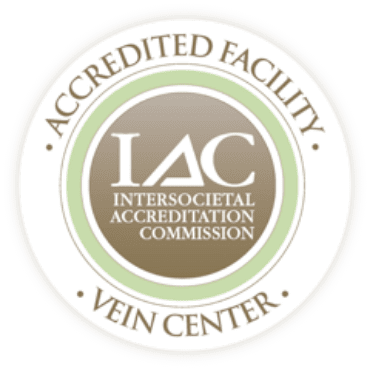We have all seen someone walking down the street, noticed large bulging varicose veins, and known they have venous disease. Although varicose veins and prominent spider veins are the most obvious sign of venous disease, the medical condition they represent, venous insufficiency, is much more than just varicose veins. Venous insufficiency can manifest as a variety of signs or symptoms, some of which may be dermatologic in nature. Thickened and discolored leg skin or non-healing biopsy sites may not immediately come to mind when thinking about vein disease.
Venous insufficiency is a very common and often under-diagnosed condition affecting millions of Americans. It is estimated to be present in as much as 40% of the population and becomes more prevalent after age 50. Heredity is a major risk factor, as are a history of blood clots or DVT, obesity, standing or sedentary occupation, female gender and prior pregnancies although the condition afflicts many men as well.
Venous insufficiency is a condition that develops over time as the valves in the leg veins that keep blood flowing back to the heart fail. This leads to pooling of blood in the legs which causes increased pressure in the venous system. The venous hypertension in the leg veins leads to the signs and symptoms associated with venous insufficiency, which often worsens as the day progresses.
Most people are aware of the most common sign of venous insufficiency which is varicose veins, but many people without varicose veins may also have the condition. Leg swelling as well as achy, heavy or tired legs at the end of the day are the most common symptoms & signs of venous insufficiency. Patients with venous insufficiency can also suffer from disrupted sleep due to restless legs syndrome (RLS), night time leg cramps, or excessive urination, the nighttime triad.
The most common dermatologic manifestation of venous hypertension is the appearance of new veins or clusters of veins especially on the lower legs and feet. This can lead to the feet and lower legs developing a purplish discoloration, especially when standing.
Skin changes and discoloration become more pronounced and severe as venous disease progresses. As the pressure builds in the veins throughout the day, fluid leaks out of the veins causing edema or swelling. In severe cases blistering or weeping of the serum out of the skin can develop making patients susceptible to skin infections called cellulites. Over time this leads to inflammation of the skin and subcutaneous tissues in the lower leg, a condition known as stasis dermatitis.
Stasis dermatitis can initially manifest as dry, flaky, itchy skin or “venous eczema”. The continued leaking of fluid and blood cells out of the veins leads to a brownish discoloration or staining of the skin and ultimately thickened, leathery skin that can encircle the lower leg and be more likely to ulcerate.
Call Or Request An Appointment
Contact us to schedule an appointment with our expert Vein Specialists team. We will evaluate your signs and symptoms, answer your questions, and create a personalized vein care treatment plan to relieve your leg pain and enhance your life.
Schedule Your Appointment TodayStasis dermatitis is a clinical diagnosis made by inspection of the skin and does not necessarily require a biopsy. Skin biopsies or any minor trauma to the area can lead to wound or ulcer development that can be very difficult to heal. Stasis dermatitis should not be treated with long term steroids or other creams. Treating the underlying venous condition is the only way to halt the progression of the disease.
Modern vein evaluation and intervention is much different than it was years ago. Prior to 2000, procedures such as vein stripping were very invasive, required general anesthesia, and had unacceptably high complication rates. For this reason, most patients with venous insufficiency were left suffering. Thankfully, this is no longer the case as of the year 2000.
At Vein Specialists in Fort Myers and Bonita Springs/Naples, we offer comprehensive, modern vein evaluation and care. I am a board certified Vascular Surgeon focused 100% on the management of venous disease. We start by taking a detailed history and physical exam and then offer detailed ultrasound evaluations in our office by our on-site team of highly trained registered sonographers. We are then able to formulate a specific treatment plan tailored to each patient.
Often the best treatment option for patients with venous insufficiency is something called endovenous ablation or vein closure (permanently closing the vein with heat or medical adhesive). Closing poorly functioning veins decreases the venous pressure in the leg and significantly improves signs & symptoms of venous insufficiency. This procedure is minimally invasive and is offered under local anesthesia in both of our locations with minimal discomfort and almost immediately return to normal activity.
If you or a loved one is concerned by skin changes occurring on your lower legs or if you are experiencing any of the other signs or symptoms associated with venous insufficiency, please visit our website at weknowveins.com or call us at 239-694-VEIN(8346) for more information. I see patients along with our four highly trained advanced practitioners in both of our Fort Myers and Bonita Springs/Naples locations,
Request an Appointment
Please take a moment and fill out your request below and one of our staff members will be in contact within 24-48 business hours. If this is an emergency, call 911 immediately. If this is a non-emergent concern, please call the office Monday-Friday between 8am – 5pm at: 239-694-8346


